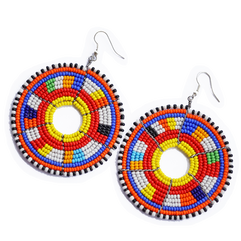Wen you think about Africa, you imagine the exotic animals, the lions, the Serengeti National Park and perhaps the various National Geographic episodes you have seen. One aspect we do not think much of is the cultural abundance that makes Africa rich in diversity. During my holiday in Africa in 2012, I instantly fell in love with the people, landscapes, animals and of course their jewellery. Today, Zambilla & Co offers a range of handpicked African jewellery ranging from earrings, necklaces and bracelets to the Australian market.
The continent of African comprises of 54 Countries, more than 1.3 Billion people and more than 3000 tribes! Each tribe may have their own unique dances, clothing and of course jewellery. I visited the beautiful country of Tanzania and instantly fell in love with the vibrance, intricacy and quality of the Maasai jewellery that the local women wore and made along the local stores. During my holiday in Tanzania, I met Raymond, a hardworking young man who did tour guiding at the Arusha Tourism Centre. 6 years on, Raymond assist us with hand picking a range of jewellery directly from the women who create these amazing pieces and it provides a vital income for their livelihoods. Despite the decorative aspects of their creations, the beaded jewellery plays a vital aspect to Maasai culture.

According to Thompson Safaris' recent blog they mention 5 interesting facts about Maasai beaded jewellery.
1. THE BEADED ORNAMENTS REPRESENT MAASAI CULTURAL VALUES AND TRADITIONS.
The practice is done specifically by women, and it’s considered their duty to learn beadwork. These products are for both men and women, and they’re used in cultural practices such as weddings, rituals, and community events.

2. MAASAI BEADWORK HAS BEEN IN EXISTENCE FOR HUNDREDS OF YEARS.
The tradition of Maasai beadwork dates back hundreds of years. It became significant and known to the rest of the world in the 19th century after trade with other tribes.
3. BEADS WEREN’T THE ORIGINAL MATERIAL USED.
Initially, Maasai women used dried grass, sticks, clay, seeds, and shells as materials to make the traditional ornaments. Over time, they began using attractive beads made of plastic and glass that they obtained from other communities through trade.

4. MAASAI BEADWORK IS WORN ACCORDING TO THE AGE AND SOCIAL STATUS OF AN INDIVIDUAL.
Unmarried females wear large flat beaded discs around their neck when dancing as a sign of grace and flexibility. A woman getting married wears a very elaborate and heavily beaded neck piece on her wedding day, and once married, she wears a long necklace with blue beads. Those of a higher social status wear more colourful beads.

5. DIFFERENT COLORS HOLD SPECIAL MEANING.
There are a number of different colours used in Maasai beadwork, and each one holds a special meaning: red signifies blood, bravery, and unity. White represents health, peace, and purity. Blue is the colour of the sky and represents energy, and green is the colour of grass, which signifies the land and production. Black represents the people and the struggle they must endure. Yellow symbolizes the sun, fertility, and growth, and orange represents warmth, generosity, and friendship.

The Zambilla & Co proudly offers a range of traditional Maasai jewellery to the Australian Market and incorporates a range of earrings, bracelets and necklaces that are genuinely handmade by Maasai women in Tanzania. These stunning pieces are so vibrant and unique they are sure to make you stand out. Through each purchase, we are able to directly support the women who create jewellery for a living. Please explore our African Collection online today and enjoy FREE standard shipping Australia wide.
PS: The Large Round Massai Necklaces (2nd Row Above) look fabulous worn or framed as a decorated piece for your home!

Sources
Thompson Safaris: https://thomsonsafaris.com/blog/5-things-didnt-know-maasai-beadwork/













































